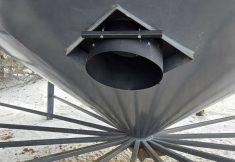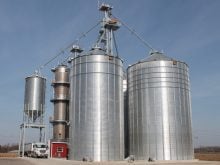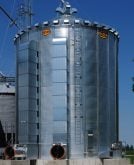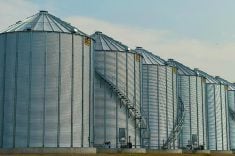Getting canola off the field and into a bin is just half the battle – now you need to keep it in condition and avoid spoilage during the crititcal winter months.
This fight starts at harvest time, said Breanna Miller, agronomy specialist for the Canola Council of Canada, with moisture levels — anything that is coming off at less than eight per cent moisture is relatively safe for storage.
“We had some fairly dry canola right across the Prairies this year,” said Miller, who is based in Portage La Prairie, Man. “However, the temperatures were so hot at harvest, so we really encouraged running fans to try and cool it off and get some air in the bin.”
Read Also

Cancer agency reclassifies another herbicide ‘probably carcinogenic’
The WHO’s cancer research agency has now put atrazine, a herbicide well known to corn growers, in the same potential-hazard category where the agency put glyphosate.
At harvest, it’s good to be aware of green canola, weeds and insects that can raise the heat over winter. This fall, some canola went into the bins extremely hot, and stayed in there, posing a potential storage and spoilage issue. Spoilage can happen anytime, even shortly after harvest, if canola goes into the bin a little too moist or too hot.
“That canola goes straight into the bin and is cooped up without any airflow,” she said. “Again, a lot of [farmers] were running their fans trying to get some air movement in there, when the humidity wasn’t up outside.”
It’s extremely important to watch for hot canola and spoilage throughout the winter.
“At this time of year, when the outside of the bin is so cold, we start to have cold air and cold canola on the outside of the bin, with that really hot canola inside,” she said.
This is when growers can run into condensation and some spoilage occurring, especially when the canola starts to heat.
“It’s really important to run fans, kind of early in the season, to get the air flow in there, and try to cool things down,” she said.
Running fans when it is cold outside to try and get some of the cool air through the bin and circulate that air is also beneficial, she said. Temperature and moisture can be issues once condensation occurs. Warm air in the centre of the bin can rise and cools off once it hits some of the cooler surrounding canola, or cooler air. When moisture is released, the hot canola can affect the cooler canola, and there can be heat, and spoilage.
Storing canola dry is very important, said Miller.
“We want to store the canola at eight per cent moisture,” she said. “But a hot temperature can also lead to condensation, and there can be mixtures of the two temperatures.”
Hot canola is warm to the touch and smells spoiled. Sometimes steam can rise off it. In winter, if a producer suspects they have hot canola, they really want to take advantage of the colder outside temperature.
“Running our fans to try and suck in that cold outside air and put it to the centre of the bin, where we have that warm air, where we’re going to see the issues. If a grower doesn’t have aeration or fans, it’s a good idea to ‘spin the bin’,” she said. This means taking out some canola out of the bin, which some of the heat from the middle warm pocket. The canola can then be augured back on top. That distributes the heat and helps to get cooler air and cooler grain mixed in. Sometimes a producer can find heated pockets before it becomes a big issue, said Miller.
“It’s really good to take out some loads, run that fan again, and try and get that temperature down and move that canola out as soon as possible,” she said.
This can be done throughout the winter.

“If you’re selling and moving some canola through the winter, maybe pull some different bins, just make sure you’re getting some samples from each bin, and keep things moving through the winter,” she said.
Miller said producers should be diligent in checking and taking samples from their bins, especially if they are planning to store their canola for long periods.
“The longer it’s stored, the higher the risk that there’s some issues,” she said.
Even canola that is in the bin for a couple months needs proper airflow. Green canola, green chaff, weed seeds and even insects like grasshoppers can bring up the moisture content inside the bin.
“It’s hard to know how much it’s actually providing, but it does slowly kick that moisture content up without us knowing,” she said.
Large bins are a challenge, because of air flow issues.
“There’s a lot of grain and you’re trying to force the air through,” said Miller. Having a small bin will make this a lot easier.
“The larger the bin, the harder it is to push that air right through. It can be a little harder to get a relative sample of a large bin versus a smaller bin,” she said.
Some farms use sensors inside their bins that monitor temperatures and alert them if there’s an issue. Even with the sensors, Miller said it’s a still a good idea to take sample and run fans.
















